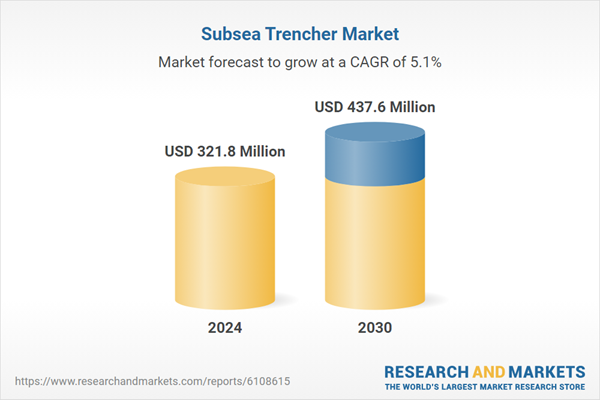Speak directly to the analyst to clarify any post sales queries you may have.
10% Free customizationThis report comes with 10% free customization, enabling you to add data that meets your specific business needs.
Key Market Drivers
Growth in Offshore Oil & Gas Exploration and Production
The continued expansion of offshore oil and gas projects, particularly in deep and ultra-deepwater environments, is a key factor propelling the subsea trencher market. As conventional reserves diminish, exploration efforts have shifted toward more remote subsea locations requiring robust infrastructure to transport hydrocarbons and control signals. Subsea trenchers are indispensable for securing pipelines and umbilicals beneath the seabed to shield them from physical and environmental hazards, including ocean currents and fishing equipment. These systems also enhance thermal insulation, critical for flow efficiency in colder depths. Major offshore investment hubs such as Brazil, Norway, the Gulf of Mexico, and Southeast Asia are expected to remain active, supporting long-term market demand for advanced trenching equipment.Key Market Challenges
High Capital and Operational Costs
A major challenge in the subsea trencher market is the significant cost associated with acquiring, deploying, and maintaining advanced trenching systems. Deepwater-capable trenchers incorporate sophisticated features such as autonomous navigation, high-resolution sonar, and GPS tracking, which contribute to high upfront expenses. Operational deployment further involves support vessels, ROVs, and expert personnel - driving up day rates, especially in challenging marine settings. Maintenance costs are also elevated due to the complexity of the equipment and difficulty accessing damaged units underwater. These high costs can deter investment, particularly in budget-constrained projects or emerging offshore regions, limiting market penetration and slowing equipment upgrades.Key Market Trends
Increasing Adoption of Autonomous and Remote-Controlled Trenching Technologies
A significant trend shaping the subsea trencher market is the shift toward autonomous and remotely controlled trenching systems. These advanced trenchers use embedded sensors, sonar imaging, AI-based controls, and GPS guidance to perform precision trenching in complex subsea terrains with minimal human intervention. Such capabilities improve safety, enhance efficiency, and reduce the environmental impact of operations. Additionally, ROV-based trenching systems allow operators to manage operations from surface vessels or remote locations, decreasing offshore crew requirements. These innovations are becoming increasingly relevant for offshore wind, telecom, and deepwater oil and gas developments, where performance reliability and reduced downtime are crucial.Key Market Players
- Oceaneering International, Inc.
- Royal IHC
- Soil Machine Dynamics Ltd. (SMD)
- Saab Seaeye Ltd.
- Forum Energy Technologies, Inc.
- Seatools B.V.
- DeepOcean Group Holding BV
- Helix Energy Solutions Group, Inc.
Report Scope:
In this report, the Global Subsea Trencher Market has been segmented into the following categories, in addition to the industry trends which have also been detailed below:Subsea Trencher Market, By Type:
- Jet
- Mechanical
Subsea Trencher Market, By Application:
- Pipeline Burial
- Cable Burial
- Umbilical Burial
- Others
Subsea Trencher Market, By Region:
- North America
- United States
- Canada
- Mexico
- Europe
- Germany
- France
- United Kingdom
- Italy
- Spain
- Asia Pacific
- China
- India
- Japan
- South Korea
- Australia
- South America
- Brazil
- Colombia
- Argentina
- Middle East & Africa
- Saudi Arabia
- UAE
- South Africa
Competitive Landscape
Company Profiles: Detailed analysis of the major companies present in the Global Subsea Trencher Market.Available Customizations
With the given market data, the publisher offers customizations according to a company's specific needs. The following customization options are available for the report.Company Information
- Detailed analysis and profiling of additional market players (up to five).
This product will be delivered within 1-3 business days.
Table of Contents
Companies Mentioned
- Oceaneering International, Inc.
- Royal IHC
- Soil Machine Dynamics Ltd. (SMD)
- Saab Seaeye Ltd.
- Forum Energy Technologies, Inc.
- Seatools B.V.
- DeepOcean Group Holding BV
- Helix Energy Solutions Group, Inc.
Table Information
| Report Attribute | Details |
|---|---|
| No. of Pages | 188 |
| Published | July 2025 |
| Forecast Period | 2024 - 2030 |
| Estimated Market Value ( USD | $ 321.8 Million |
| Forecasted Market Value ( USD | $ 437.6 Million |
| Compound Annual Growth Rate | 5.1% |
| Regions Covered | Global |
| No. of Companies Mentioned | 8 |









